Markos Kay is a digital artist, director, and lecturer based in London. He is best known for his artificial life video art experiment aDiatomea, exhibited at Haeckel’s Phyletic Museum.
His work can be described as an ongoing abstraction and visualizing of the microscopic worlds through computer simulations and generative techniques. These experiments explore the scientific methods and processes that reveal information about the complexity and emergence of the invisible.
Labocine sits down with Markos for a short interview of his work that breaks the boundaries between scientific data and imaginary realms.
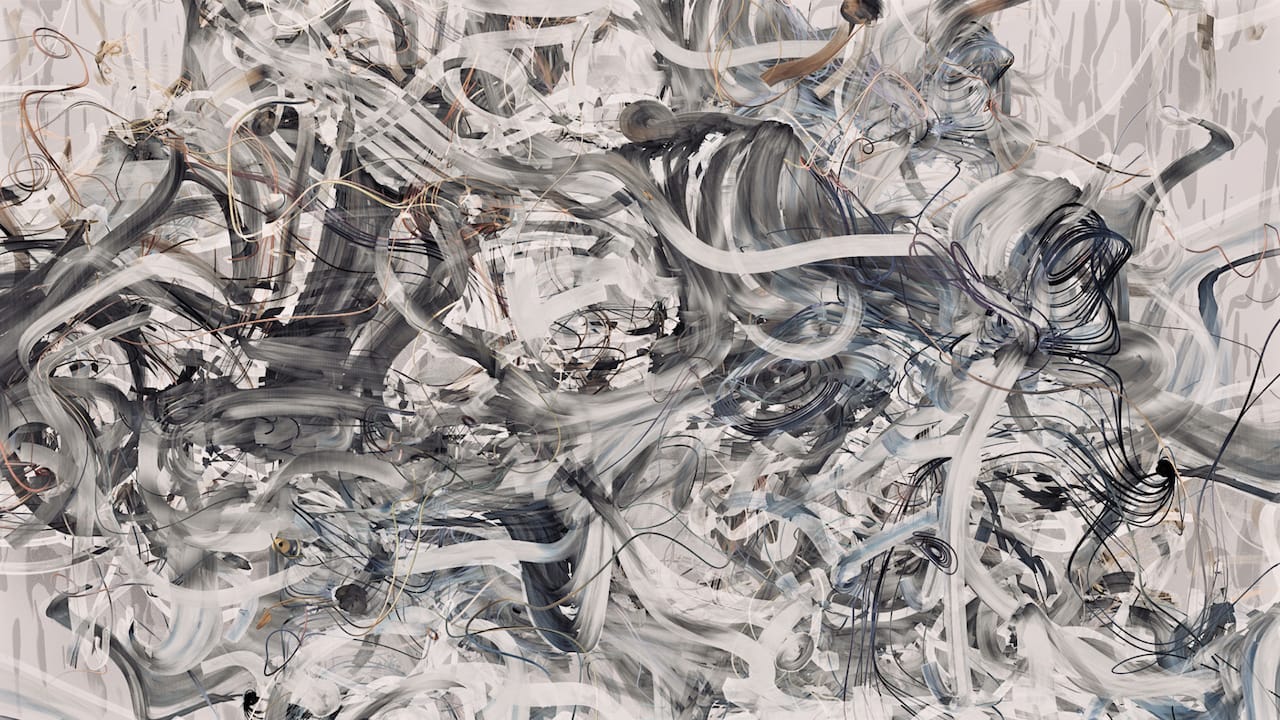
Caption: from “Quantum Fluctuations”
Can you talk a little a bit about your process and how does it relate to scientific data?
My art & science work is mostly focused on the theory behind scientific observations, so a lot of my process involves extensive secondary research. For example, when I started working on The Flow, I spent about a year researching the theoretical background before even beginning to create anything.
When dealing with scientific subjects, it is very important to get the facts right, and since I have no formal education as a scientist, it is even more important to make sure I have understood the theory correctly. Besides theoretical research, I also spend a lot of time doing visual research, especially into scientific iconography and imagery as a lot of my work deals with how this visual language influences the way we understand science.
The creative process starts with pen and paper where I flesh out the overall narrative structure and general form of what I want to create. I find that drawing is a crucial aspect of the creative process as it allows for a more intuitive translation of what I have in mind.
I try to encourage my students to start their projects with drawing rather than going straight to the computer as I believe this helps to create something unique and personal rather than something generic dictated by the computer interface.
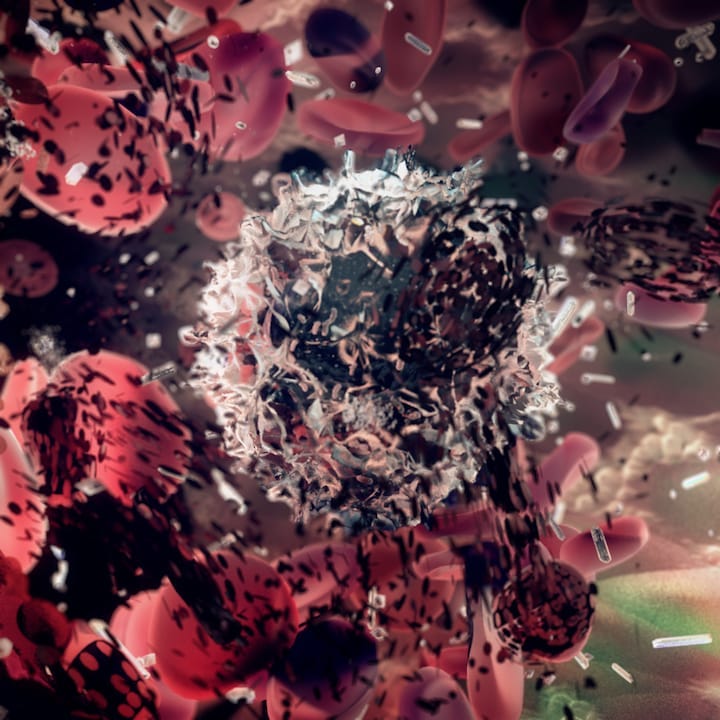
Image From "Powers of 10"
When sufficient exploration has been done in my sketchbooks, I move to the computer where I experiment with parametric systems that are set into motion to generate emergent structures and interactions.
Using simulations as an artistic tool requires a lot of trial and error, and it's really a selective process. It involves setting initial conditions such as the physical forces, properties and entities of a virtual environment, running the simulation to see how it evolves, then going back and adjusting the parameters to create different iterations. Then it is a matter of selecting one particular iteration and recording it.
The way I like to see it is that it’s like filming a nature documentary, where events are recorded with no intervention, and then the best shots are chosen. Similarly, with simulations, there is no control over the way the virtual events unfold, but there is control over their initial parameters. This was first explored in my project aDiatomea, where virtual organisms were set loose in a simulated environment, and their movement was recorded using randomly placed cameras that were also subject to the forces of the simulation.
Simulations, of course, play an important role in modern science, often studied like laboratory phenomena. I've taken this scientific process and have used it to communicate complex scientific narratives but also analyse the impact of the language of simulations on human understanding.
Most of my work uses simulations as the brush and paint to create abstract representations of scientific narratives. In Cytoplasmic Playgrounds, for example, I set out to create entirely abstract interpretations of subcellular micro-events.
However, I have also incorporated actual scientific data in Microscopic Leaps in the form of 3D scans of cells that were sent to me by the scientists at the HMMI.
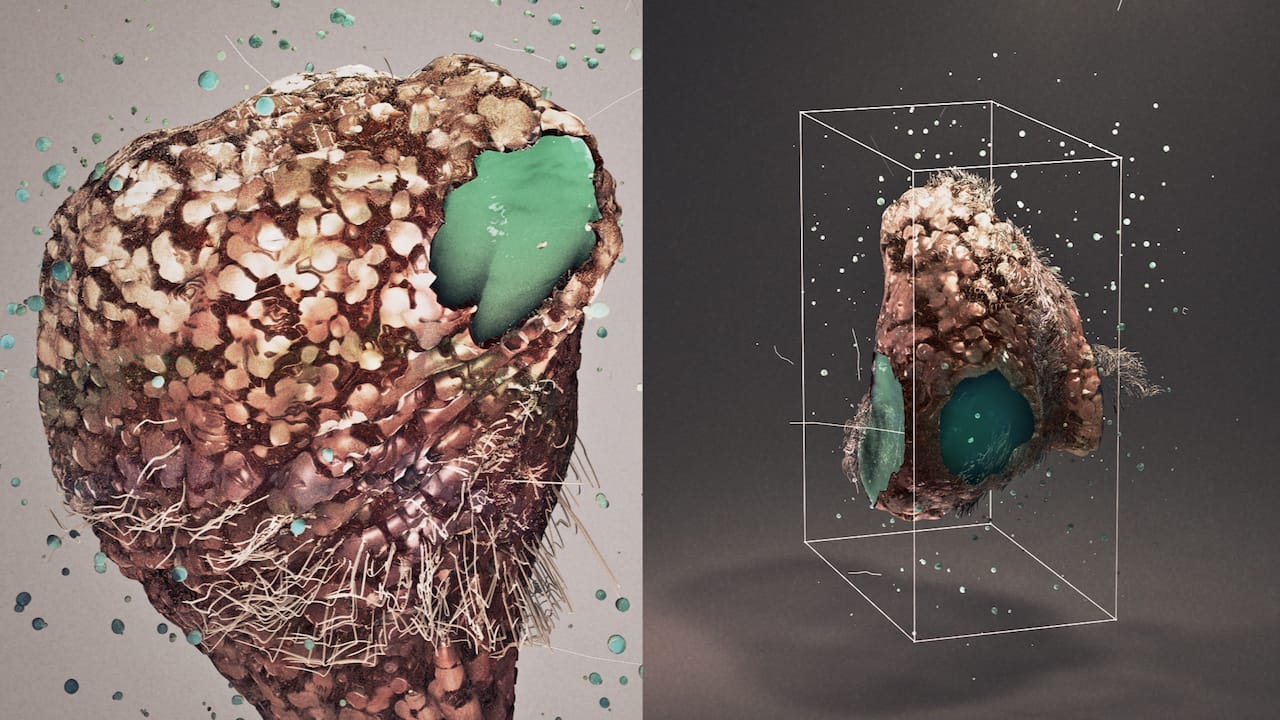
Image from "Microscopic Leaps"
Describe how all of these videos featured are connected ? Provide a narrative fabric tying them together - common themes, technique, etc.
The main theme of my work is based on the idea of transformation of information which can be seen throughout the scientific narrative. In the Big Bang story, we see the transformation of particles into atoms, stars and so on. If we look at ourselves we see a similar story; we are made of atoms that construct molecules and cells, the story of supervenience and emergence.
Looking at the greater picture we can see information increasing in complexity as it transforms from one level to the next, each with its own emergent properties. If we look at the smallest picture, we can see the same thing, fields that interact with each other through the exchange of information in the form of particles.
This concept was explored in The Flow and if you visit the project’s micro-site (www.mrkism.com/flow) you can read a more in-depth analysis of it. The idea of supervenience is best exemplified in the seminal film The Powers of Ten by Ray and Charles Eames which has been a great influence to my work and I had the pleasure of being a part of an international collaboration to reimagine this film for its 35th anniversary. (www.mrkism.com/powers.html)
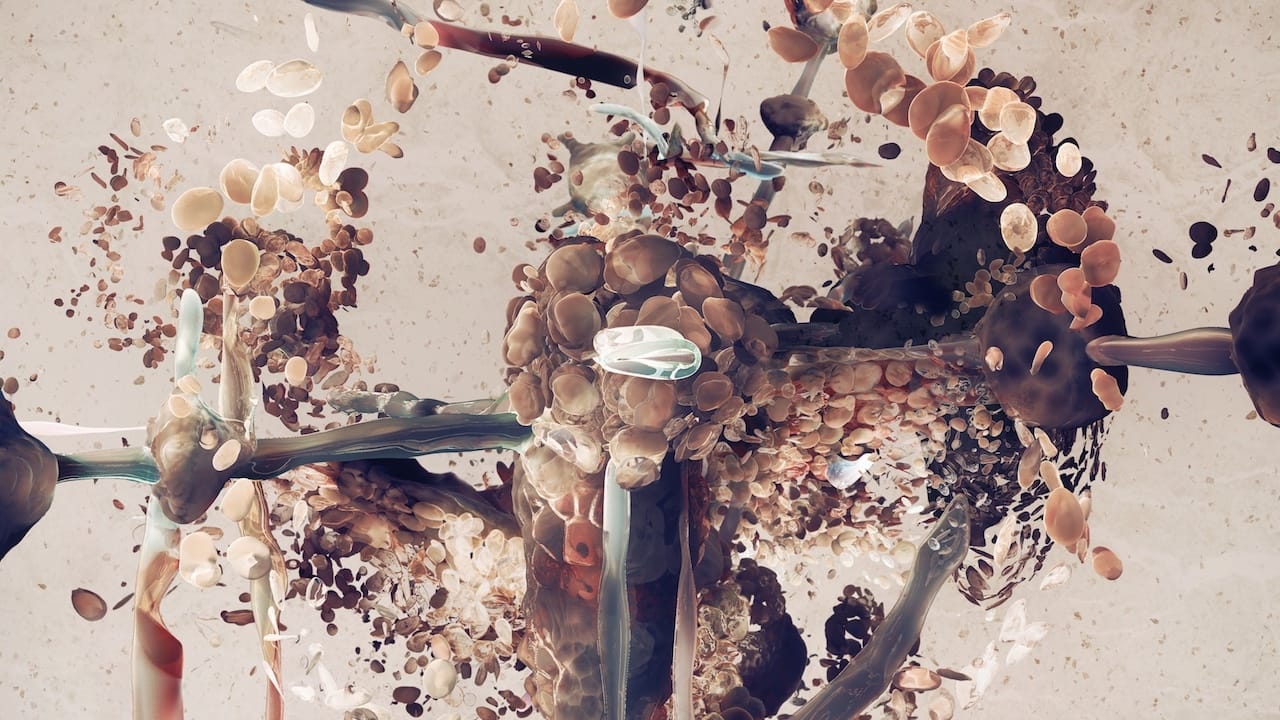
From "Cytoplasmic Playgrounds"
In the act of observation there is another kind of transformation that occurs. In visual perception, light information is transformed, processed and reinterpreted through the various structures of the brain to create a representation of phenomena. In scientific observation, our instruments intervene to translate information into perceptible forms from aspects of reality that cannot be directly observed.
Thus, the scientific narrative mediates information, transforming it into emergent orders of complexity to produce scientific knowledge. This knowledge is further abstracted or transformed when it is represented in visual form.
Scientific visualisation has its own language and iconography as expressed in illustrative, diagrammatic and imaging methods. These visualisations communicate scientific observations, guiding and forming the way this knowledge is perceived and understood. There is a critical shift in perspective that occurs in the process of verifying theory through tools of observation such as sensors and simulations and in the way that informatiuison is communicated through visualisation.
In both aDiatomea and Microscopic Leaps, I explore how the scientific instruments of observation and the visual interpretation of these observations instigate this shift in perspective.
Digital physics suggests that reality is inherently informational and possibly computational. This very idea is put into practice in particle accelerators where supercomputer simulations are used to verify observations of particle interactions, something I explore in Quantum Fluctuations.
In aDiatomea I took the concept of pancomputationalism to recreate the forms of unicellular organisms using a mathematical formula, exploring the possibility of simulating life using ‘pure’ information. (More details at the project’s micro site www.mrkism.com/diatomea).
The concept of “information” has become the overarching paradigm of modern science. Through my work, my aim is to deconstruct this paradigm that shapes scientific knowledge and the way it is interpreted and perceived in a visual manner.
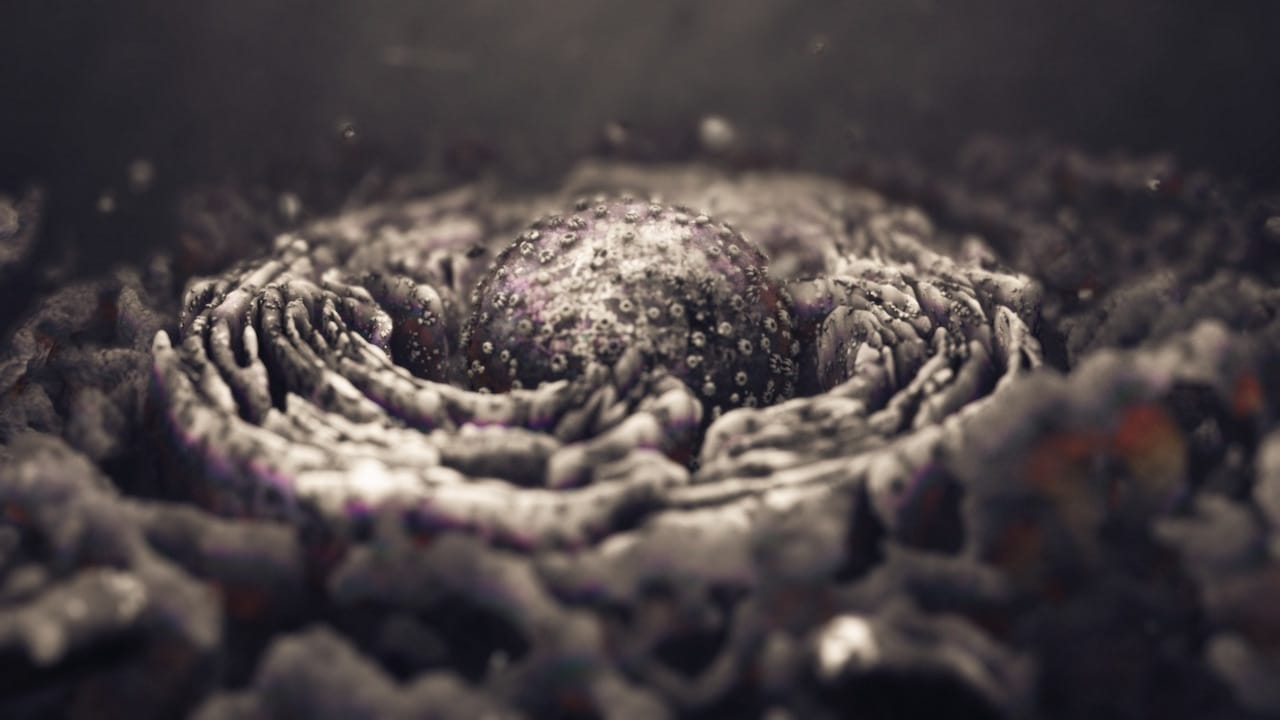
Image from "The Flow"
How do your visualizations help you understand or see science in a different way?
I think these visualisations of scientific narratives are ways of looking at the bigger picture. What interests me is to find the patterns that repeat in all aspects of reality from the microcosm to the macrocosm. There is an emerging academic discipline called “Big History” that brings together different disciplines that describe the universe, from particle physics to astrophysics to geology to biology to humanities and everything in between.
The aim is the same, to find those repeating patterns that govern the universe and ourselves and therefore deepen our understanding of reality. Science in its current form is very fragmented in its many disciplines, which serves its purpose of course but I think an effort to unify it all can lead to important paradigm shifts.
"From an artistic perspective science is an extremely powerful metanarrative and is therefore a subject that needs to be deconstructed through art."
Science can profoundly change the way we understand the universe but also our societies and our minds. From an artistic perspective, science is an extremely powerful metanarrative and is, therefore, a subject that needs to be deconstructed through art.
The scientific method itself can be seen as an artistic process – it aims to answer questions about how the world works, but more importantly, it creates more questions about reality. It deconstructs and reconstructs knowledge, and it uncovers beauty, complexity, and simplicity just like art.
The desire of artists to find ways to understand, represent and reinterpret the world they live in gives rise to in an investigation of nature, perception and thought - which is exactly what a scientist does.
Where and how do your animations get featured? What has been the response in the scientific community but also more broadly the public, film world?
My works usually get featured at science and digital arts festivals, screening events, exhibitions and at academic or research institutions. They also get featured in online and printed publications within the sphere of art, design, and science. The most exciting feature I've had was my first art & science work aDiatomea that was shown at Ernst Haeckel’s Phyletic Museum in Germany. Haeckel has really been a great influence on my work so it was a great honour. Probably the most unexpected feature was having a portion of The Flow shown in an episode of Breaking Bad! An upcoming feature I'm looking forward to will be in a documentary about art & science focusing on the CERN called “Sense of Beauty”.
In general, the scientific community has been supportive of my work commending me on how I can visualise complex theory in an informative way while also engaging the general public with science. Similarly, public response has been very positive, and I feel that people engage with the complexities of science on a more intuitive level without having to delve into the intricacies of the theory behind it.
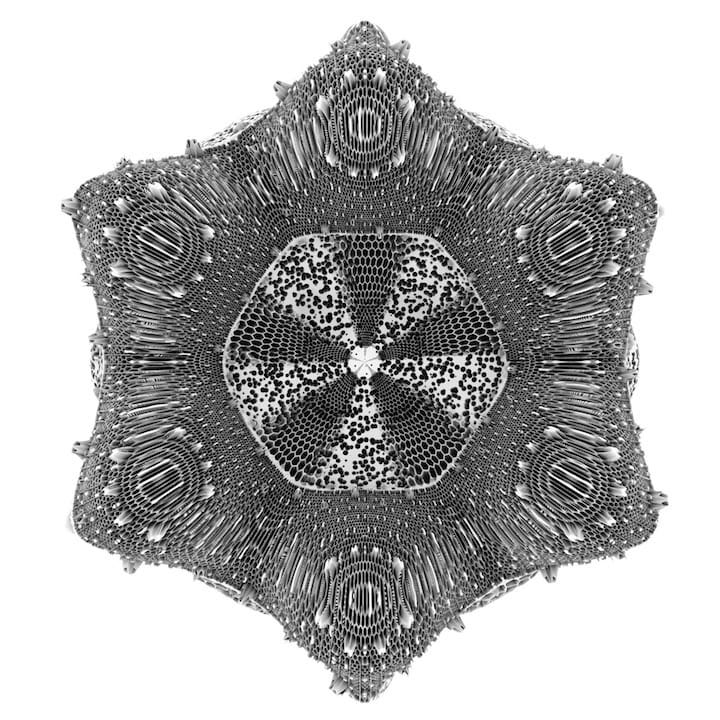
Image from "aDiatomea"
What are your upcoming projects?
I am working on multiple projects at the moment, some of which have been in development for many years and some that go beyond scientific topics. One that is nearly finished is a collaboration with photographer Jan Kriwol. We are combining his beautiful photos of urban environments with anatomical renderings of the circulatory system. Anatomy has always been a passion of mine and probably what lead me into the area of art & science, so I’m very excited to be finally releasing a project that focuses on that. Another biology-related project that is near completion is called “Messages from the Microbiome” which is a series of typographic illustrations that communicate the impact of the microbiome on our bodies.
I have also started an ongoing project on Instagram (@mrk.ism) called “Experiments from the Lab” where I am documenting all my experimentation from past and present projects. I have found this to be really useful – by putting out work in progress into the public sphere it gives it another dimension, pushing the work further.
Two related projects that I am very excited about look at this deconstruction of knowledge that I have talked about before. Just like the Instagram experiments, these two projects are open ended, so it's really an ongoing series of artworks. The first project is a series of animations and digital illustrations and the second is a series of prints in the form of riso zines, textiles and ceramics.
I also have several projects that are in early stage development. I am looking at exploring the 3-dimensional structure of the CMB and how it relates to other macrocosmic structures from heliospheres to superclusters. I am also working on an illustration project visualising druse which are little crystalline structures that sometimes develop in plant cells. Finally, I am working on a more reflective artistic project which is a deconstructive reinterpretation of some classic pieces of art.
Interview conducted by Alexis Gambis, Executive Director of Imagine Science Films